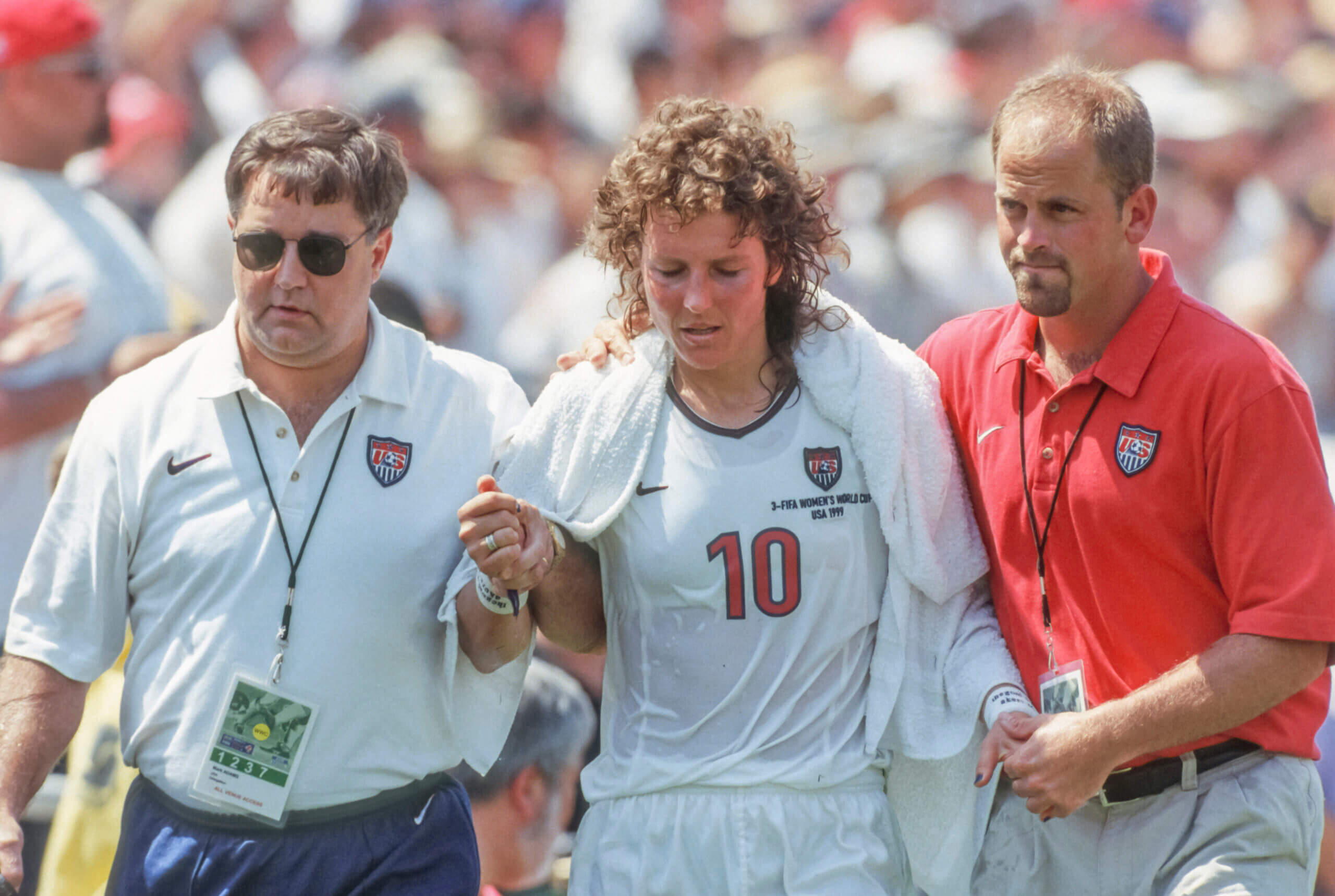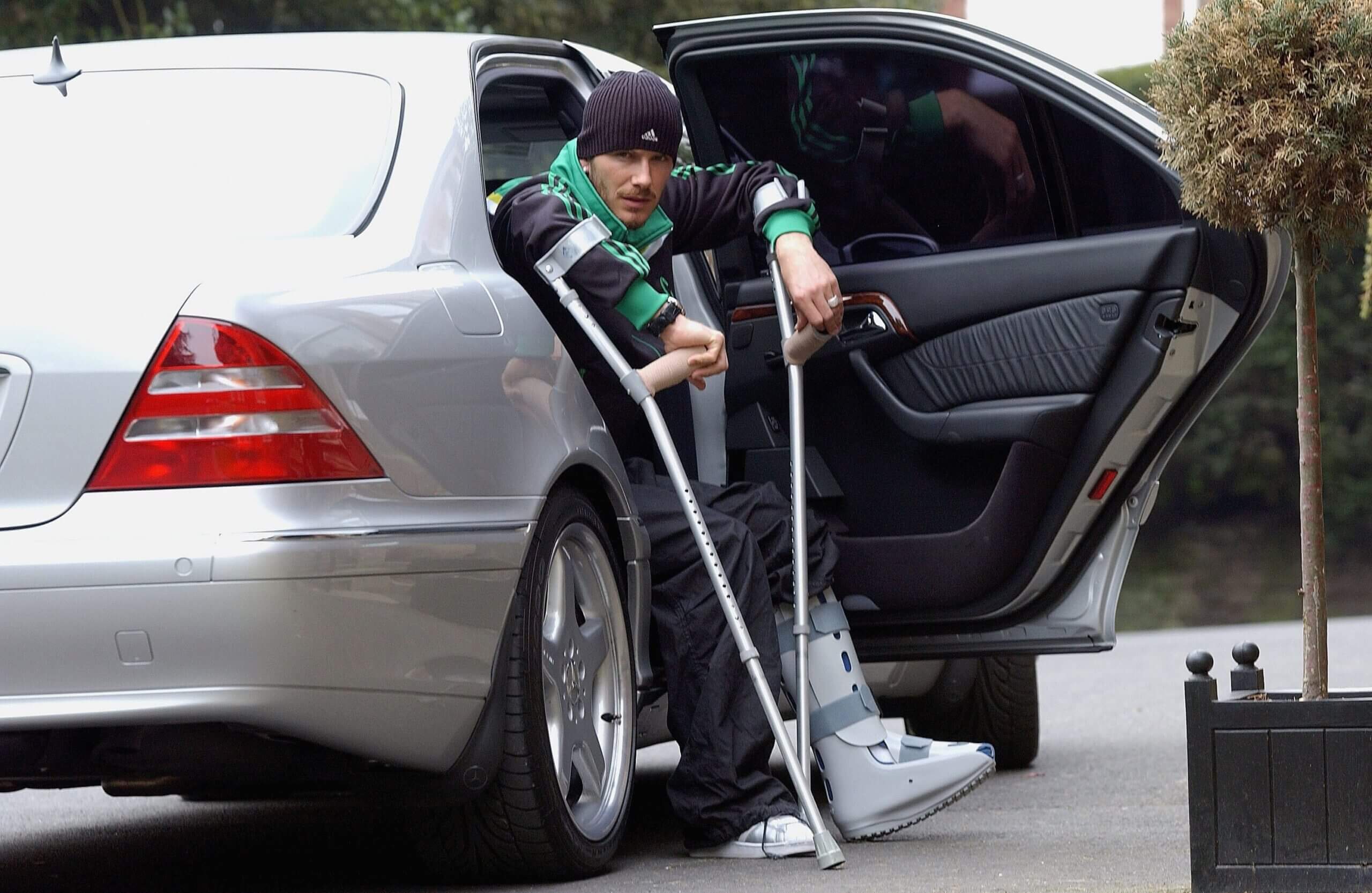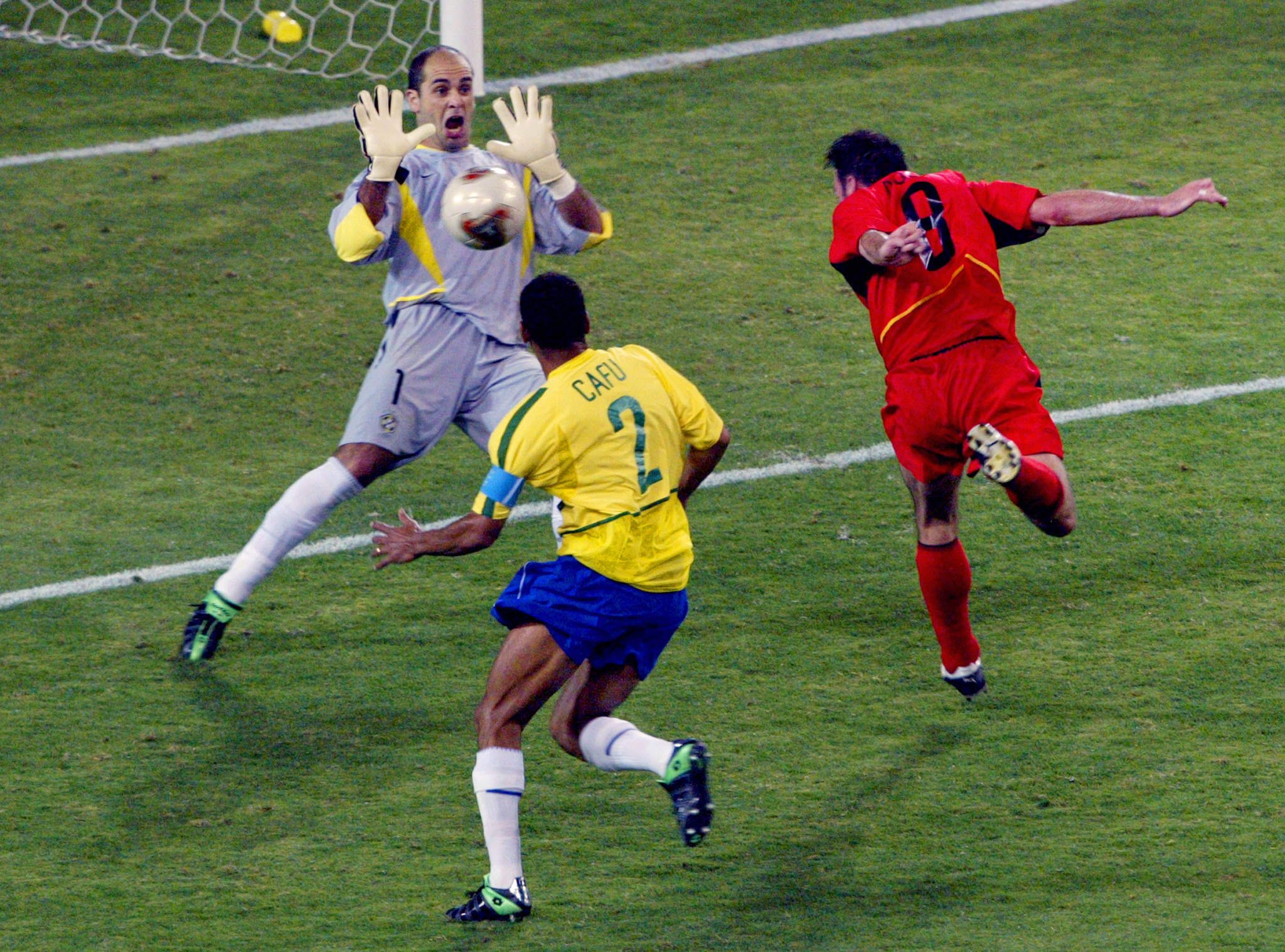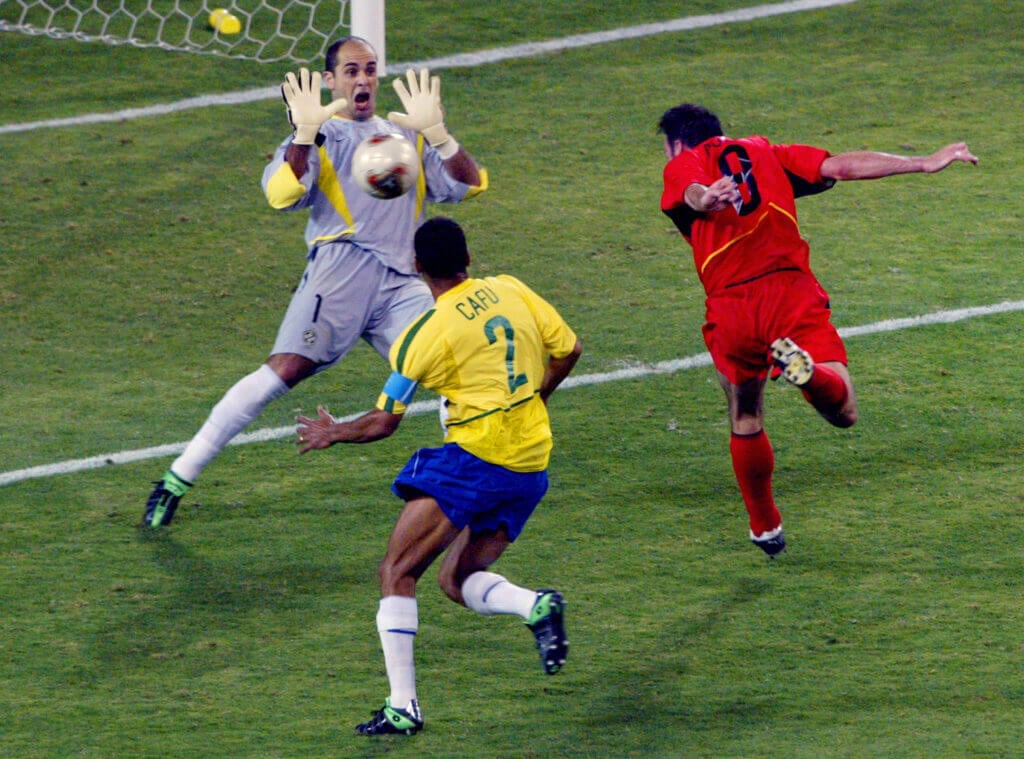Australia’s defeat to Nigeria complicated a few things for head coach Tony Gustavsson.
Had they won that second group game they would be safely through to the knockout stages, they would have been able to take things a little easier in the final fixture against Canada and maybe rest a few players.
But perhaps most importantly, the decision over whether to risk Sam Kerr would have been much more straightforward.
Advertisement
Kerr was dramatically ruled out of Australia’s opening game of the Women’s World Cup with a calf injury, that they initially reported would keep her out of their first two fixtures. That would theoretically make her available for the co-hosts’ final group game which, following the 3-2 loss to Nigeria, is effectively now a must-win. A draw could be enough, but only via a slightly implausible set of circumstances involving a heavy defeat for the Super Falcons against Ireland.
The question now becomes: should Gustavsson risk Kerr? In any normal circumstances, a calf injury of this nature would not be the sort of thing a coach would gamble on only a week after the player in question suffered it, but these are not normal circumstances.
On Saturday Kerr gave a hotly-anticipated press conference, the kind that has a nation waiting anxiously for good news but also fearing the worst. In this case, Kerr was able to offer hope.
“I’m definitely going to be available (to face Canada on Monday) but how we decide to use that is not to be given to the opposition,” she said. “That’s the main thing. I would love to tell you guys everything but that’s a massive thing that the opposition want to know and, like Tony said, it’s going to go down to the wire.”
Major tournaments do funny things to people when it comes to injuries. And particularly when it involves one of your star players.
The most dramatic example in Women’s World Cup history was probably Michelle Akers, who infamously struggled through almost all of the 1999 tournament, firstly with long-term chronic fatigue syndrome, and secondly with a dislocated shoulder.
The latter was an old injury that, in slightly comic circumstances, she aggravated by high-fiving a fan before the semi-final. Nevertheless, she played in both that game, against Brazil, and the final versus China, where she eventually succumbed to heat exhaustion, almost forcibly removed from the field and spending the rest of the day on a drip.

Akers had a long history of playing through pain, having suffered a knee injury and concussion during the 1995 World Cup, and battled through a torn knee ligament at the 1996 Olympics.
Advertisement
But despite suffering the sort of injuries that would make most of us not want to get out of bed, never mind play international football, she was invariably picked by head coach Tony DiCicco because he believed her mere presence was inspiring to the rest of the team.
“The fans were treated today to witnessing one of the greatest women athletes in history,” DiCicco said after that final, “a true champion leaving it all on the field, fighting for her team-mates. Michelle Akers inspires me and I know she does the same for everybody on the U.S. team.”
That time, it worked, the USA winning the World Cup on penalties. But a year earlier in the men’s game, it quite emphatically did not. The case of Ronaldo and the 1998 final in Paris became a national scandal in Brazil, and conspiracy theories abound to this day about the reason that Mario Zagallo picked him, after he had a seizure on the afternoon of the game.
Indeed, there was a parliamentary hearing into the affair afterwards, with Zagallo and basically everyone else involved hauled up before a committee to explain themselves.
The actual reason for his selection was simple: Ronaldo was the best player in the world, he had the all-clear from a range of medics and he told Zagallo he was fine. “I didn’t give him an alternative,” Ronaldo explained. “He had no choice and accepted my decision. Then I played and maybe I affected the whole team.”
Zagallo seems to believe it wasn’t necessarily his presence in the starting XI that caused their defeat, and they may have lost anyway. “Was it his being chosen that caused Brazil to lose?” he said years later. “Absolutely not. I think it was the collective trauma, created by the atmosphere of what had happened.”
The fitness struggles of another Brazilian talisman, Neymar, were decidedly less operatic, but he basically hasn’t been fit at any of the World Cups he has played in. The broken back in 2014 was one thing, but he was significantly undercooked in 2018 and missed two games in 2022 after injuring his ankle in their opening match.
Advertisement
England have made a sport of this kind of thing over the years. It was a little more low-key than other examples, but Fran Kirby had to be very carefully managed during the women’s Euro 2022 triumph, having missed a significant chunk of the previous season with a chronic fatigue illness.
A few years earlier, Sven-Goran Eriksson took England to successive men’s World Cups with injuries to his most important player. In 2002 the nation was invited to place their hands on a picture of David Beckham’s broken metatarsal after he broke the bone in his foot in a Champions League game against Deportivo La Coruna in a challenge with Argentinian midfielder Aldo Duscher, who briefly attained public enemy No 1 status.

Eriksson later said that there was “never any discussion about whether or not he should be picked”, and ultimately Beckham did play all but 27 minutes of England’s campaign. But Brazil’s equaliser in the quarter-final did stem from him jumping out of a tackle; who knows whether it would have made a difference, but the doubt will always linger.
Wayne Rooney’s fitness in 2006 was much less clear-cut. He had to fly back to England for an X-ray during the tournament to determine his suitability to play, and he was only deemed fit enough to make two substitute appearances during the group stage.
Whether the decision to take him actually backfired is a subject of much debate, but this threw up another reason why a manager might choose an injured key player for a big tournament: public opprobrium.
“We couldn’t go to the World Cup and not take Rooney with us if there was a small chance he could be available to play,” Eriksson told the BBC recently. “The press would have killed me before the World Cup if I didn’t take him. Rightly.”
Going back a little further, England’s 1982 World Cup squad was crammed with the walking wounded, to the point that Ron Greenwood effectively took 20 men to Spain, with both Kevin Keegan and Trevor Brooking injured.
Advertisement
Keegan, in particular, was the subject of widespread national debate after he woke up one Sunday morning in April after an England game barely able to move, with back spasms forcing Brooking, his room-mate, to help him out of the bath.
Keegan didn’t play any of England’s first-round games and was forced to fly from Spain to Germany in the middle of the tournament for treatment from a specialist who had helped him with a similar problem while playing for Hamburg. Greenwood was seemingly paranoid that an Englishman requiring help from a German would be some sort of national embarrassment, so Keegan was forced to travel in disguise, borrowing a car from a hotel receptionist in Bilbao to drive to Madrid, from where he caught a flight wearing big sunglasses and a hat to hide his famous curls.
The news of his dash eventually got out, something Greenwood was particularly unhappy about, complaining that the journalist who reported the story should be “hung from a tree”, which… feels a bit much.
Ultimately, Keegan was only able to play 26 minutes of the final second-phase group game against Spain, skewing a relatively simple headed chance over the bar as England desperately sought the win that would take them through.
“Bryan Robson had put it on a plate for me and that miss is probably the only moment of my England career that people remember now,” Keegan wrote in his autobiography. “The game ended goalless and that was my one and only taste of the World Cup.”
You can very much get away with it, though, as the slightly curious case of Marcos, Brazil’s goalkeeper at the 2002 World Cup shows. After the tournament, when he was in negotiations over a transfer, it emerged that he had played the entire thing with a badly healed fractured wrist, which he simply chose not to tell anyone about. It perhaps says something about how dominant Brazil were in Japan and South Korea, but for a goalkeeper to go the whole tournament knowing that a regulation shot could be enough to snap his wrist in half is, in retrospect, extraordinary.

But there was another example of a trophy-winning team getting away with a star player’s injury. It’s broadly forgotten now, but one of the great men’s performances of all time came from a player who was injured in the lead-up to the tournament.
Advertisement
Marco van Basten suffered the first of many ankle injuries in 1986, which led to a significant operation a year later that kept him on the sidelines for much of the 1987-88 season, after which he only made a handful of substitute appearances towards the end of that campaign for AC Milan. In fact, Van Basten’s focus had been on getting fit for the following season, not that summer’s European Championship. Rinus Michels picked him in the Dutch squad, but initially Ajax forward John Bosman was preferred up front.
“It was clear in my mind,” Van Basten wrote in his autobiography. “I had no expectations because I was completely unconcerned about the Euros. Bosman was playing, I wasn’t. I was simply there to get better.”
Van Basten came off the bench in the opening game, a defeat to the USSR, but Michels made changes for the second game against England. Van Basten started, scored a hat-trick against the English, the winner in the semi-final against West Germany and that astonishing volley in the final against the Russians for the Dutch to win their first — and to date only — major men’s title.
Marco van Basten 😱🇳🇱 #UEFAEURO pic.twitter.com/L8x9afqETR
— La UEFA (@UEFAcom_it) October 31, 2019
And Van Basten actually thought his injury contributed to that incredible goal, among the greatest of all time: “The strange thing about that goal technically was that I no longer had a full range of movement in my right foot. Since my ankle ligaments had been fixed in that operation in November ’87, I had reduced mobility there and could no longer take on such a ball at full power. With a good ankle I would very probably never have scored that goal.”
Will Gustavsson take all of this into account before he decides whether to risk Kerr against Canada? Will he think it’s a gamble worth taking?
History tells us that picking an injured player at a tournament could go either way. It could be the act of a desperate coach — or an inspired move that galvanises Australia to glory.
(Top photo: Bradley Kanaris/Getty Images)
